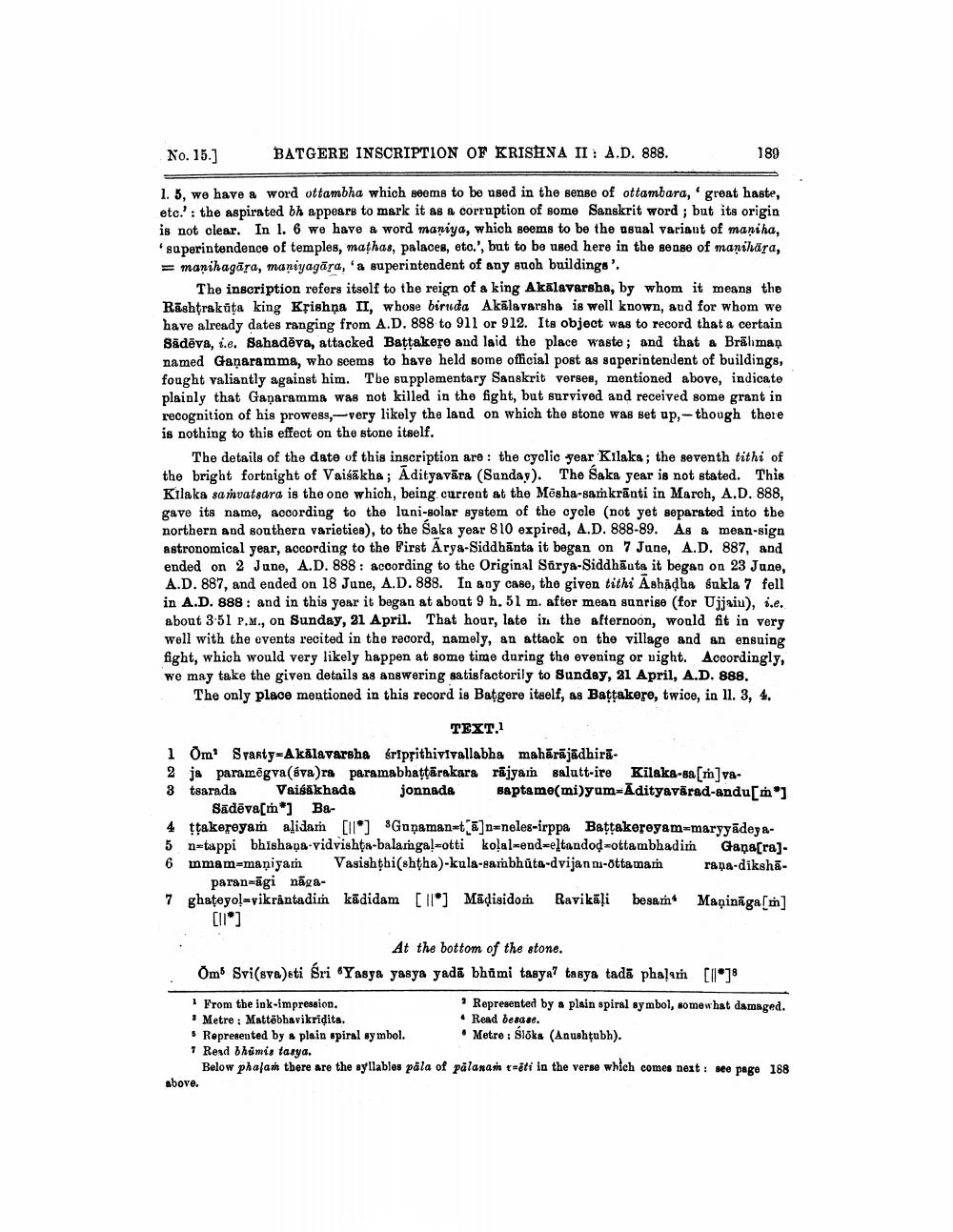________________
No. 15.7
BATGERE INSCRIPTION OF KRISTINA II: A.D. 888.
189
1. 3, we have a word ottambha which seems to be used in the sense of ottambara, 'great haste, etc.': the aspirated bh appears to mark it as a corruption of some Sanskrit word; but its origin is not clear. In 1. 6 we have a word maniya, which seems to be the asual variant of maņiha, superintendence of temples, mathas, palaces, etc.', but to be used here in the sense of manihara, = manihagāra, maniyagära, 'a superintendent of any such buildings'.
The inscription refors itself to the reign of a king Akalavarsha, by whom it means the Rashtrakūta king Krishna II, whose biruda Akālavarsha is well known, and for whom we have already dates ranging from A.D. 888 to 911 or 912. Its object was to record that a certain Sädēva, s.. Sahadēva, attacked Battakere and laid the place waste; and that a Brāliman named Gaņaramma, who seems to have held some official post as saperintendent of buildings, fought valiantly against him. Tbe supplementary Sanskrit verses, mentioned above, indicate plainly that Ganaramma was not killed in the fight, but survived and received some grant in recognition of his prowess,- very likely the land on which the stone was set up, though there is nothing to this effect on the stone itself.
The details of the date of this inscription are: the cyclic year Kilaka; the seventh tithi of the bright fortnight of Vaisakha; Adityavāra (Sunday). The Saka year is not stated. This Kilaka samvatsara is the one which, being current at the Mēsha-samkrānti in March, A.D. 888, gave its name, according to the luni-solar system of the cycle (not yet separated into the northern and southern varieties), to the Saka year 810 expired, A.D. 888-89. As a mean-sign astronomical year, according to the First Arya-Siddhānta it began on 7 June, A.D. 887, and ended on 2 June, A.D. 888: according to the Original Sürya-Siddhāuta it began on 23 June, A.D. 887, and ended on 18 June, A.D. 888. In any case, the given tithi Ashădha Sukla 7 fell in A.D. 888: and in this year it began at about 9 h.51 m. after mean sunrise (for Ujjaiu), 6.e. about 351 P.M., on Sunday, 21 April. That hour, late in the afternoon, would fit in very well with the events recited in the record, namely, an attack on the village and an ensuing fight, which would very likely happen at some time during the evening or vight. Accordingly, we may take the given details 28 answering satisfactorily to Sunday, 21 April, A.D. 888.
The only place mentioned in this record is Batgere itself, as Battakere, twice, in ll. 3, 4.
TEXT. 1 Om Syanty Akālavarsha Sriprithivivallabha mahārājadhira2 ja paramēgva(ava)ra paramabhattārakara räjyan salutt-ire Kilaka-sa[m]va3 tsarada Vaisakhada jonnada saptame(mi)yum=Adityavārad-andu[m]
Sadēva[m*] Ba4 ttakeroyam alidam [ll] Ganaman=tā]n=neles-irppa Battakereyam=maryyādeya5 n-tappi bhishana vidvishta-balamga!=otti kolal=end=eltandod=ottambhadin Gaņa[ra]. 6 mmam-maniyar Vasishthi(shtha)-kula-sambhūta-dvijan n-ottama r ana-diksha
paran=āgi nāga7 ghateyol=vikråntadim kūdidam [ll] Māļisidom Ravikāļi besam Maninagam]
At the bottom of the stone. Om Svi(sva)sti Sri 'Yasya yasya yadā bhūmi tasya? tasya tadã phalari
[11*]8
From the ink-impression.
* Represented by a plain spiral symbol, somewhat damaged. * Metre : Mattēbhavikridite.
• Read besase. 5 Represented by a plain spiral symbol. • Metre : Sloka (Anushțubh). 7 Read bhumis tasya.
Below phalan there are the syllables påla of palanan =ēti in the verso which comes next : see page 188 above.




